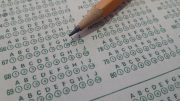With the PSAT/NMSQT behind us and the PSAT 10 and SAT coming up soon, your favorite columnists have prepared some test-taking tips and strategies. Rest assured that this won’t be your standard standardized testing advice – that is, “get a good night’s sleep before the test,” “bring a lot of #2 pencils,” etc. We’ll specifically be focusing on the process of studying for the tests.
Note: While we refer to the SAT throughout this article, our advice works for most College Board tests. We’ve used these strategies on AP exams, the PSAT, and of course, the SAT itself.
Sophomores, you don’t need to stress. The PSAT 10 doesn’t carry much significance – it’s just a baseline for your PSAT/NMSQT performance. But for juniors, the SAT will count towards college admissions. If you’re looking to improve your score from freshman year, then preparation is essential. Also, if you qualified for National Merit Semifinalist from the PSAT/NMSQT, you’ll need to score similarly well on the SAT in order to advance to Finalist status.
So here are the strategies that have helped us survive many a standardized test.
- Differentiate between “smart” and “dumb” mistakes. “Dumb mistakes” can be defined as “missing a question that you could have easily gotten right.” When scoring your practice tests, figure out why you got the question wrong. Was it because you genuinely didn’t know how to do it (i.e. a “smart” mistake)? Or was it because you thought that 3 x 4 = 7 (i.e. a dumb mistake)? This distinction will help you filter the “need-to-study” concepts versus the “forgotten-in-the-midst-of-my-sleep-deprived-delirium” concepts.
- Triage the problems. Every question on the SAT is worth the same, but not every question takes the same amount of time to answer. As such, it’s important to prioritize the questions. Vocabulary-in-context questions such as, “In this context, the word X means…” are much easier to answer than point-of-view questions like, “Passage 1’s opinion relates to Passage 2 because…” If a question is taking you too long to answer, put a dot next to it on your answer sheet and move on. If/when you finish the section, go back and review all of the dotted questions. Then, if you have time after that, do a complete review of the entire section.
- Spread out your studying. If you’re at IMSA, it’s a safe bet that you already know everything that will be on the test. So spend 15-20 minutes each day on a set of SAT Math problems, or going through one Reading or Writing passage. Just get used to the problem types and test timing. It’s easy to fit in a 15-20 minute time block during one of your free mods, or in that annoying space of time right before 10-check.
- Refrain from taking an insane number of practice tests. Take at least one practice test for preparation, but don’t blindly take practice test after practice test. It’s a waste of time. You’re better off getting super familiar with the individual sections, so that no matter how tired you are, you’ll minimize the “dumb mistakes” that you make.
- Be aware that some test prep brands are more difficult than others. I took a Barron’s practice test – under simulated testing conditions and everything – one week before the SAT. It underestimated my score by 300 points. In my experience:
- Kaplan’s word problems are longer than those on the SAT. It’s normal to feel pinched for time on those.
- Princeton Review’s Math offers a pretty good approximation of the real SAT, although it does tend to underestimate Verbal.
- Barron’s is the most difficult prep book that I used. Their Math questions are more complicated than anything on the SAT, and their Reading questions are convoluted.
- In sum, use mostly Kaplan and Princeton Review, and if you’re up for a challenge, try Barron’s. Anyway, it’s better to practice on slightly harder questions, so that the SAT will feel easy compared to all those practice tests.
- Stay alert during the test. Taking the SAT at IMSA usually entails sitting in a hot gym for an hour before the test actually starts. Since you’re not allowed to have water bottles or snacks during the test, it can be easy to get dehydrated and drowsy – thereby making you more prone to dumb mistakes. The solution: chewing gum. It makes you less thirsty and helps keep you awake. (I like to rotate between two flavors of gum – Orbit mint gum for Reading, Trident tropical flavor for Writing, and then back to mint for Math).
We hope our advice helps you prepare for the next College Board assessment you plan to take – whether that be the February SAT, the March PSAT 10, or even the AP exams in May. (You might even find that some of these tips apply to your current classes). Best of luck in your future testing endeavors!






Be the first to comment on "How to IMSA: The PSAT/SAT"